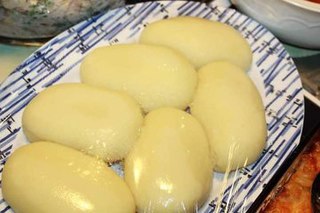
Fufu is a pounded meal found in West African cuisine. It is a Twi word that originates from the Akans in Ghana. The word has been expanded to include several variations of the pounded meal found in other African countries including Sierra Leone, Guinea, Liberia, Cote D'Ivoire, Burkina Faso, Benin, Togo, Nigeria, Cameroon, the Democratic Republic of Congo, the Central African Republic, the Republic of Congo, Angola, and Gabon.

Oshikundu or Ontaku is a traditional Namibian drink made from fermented millet (mahangu) flour, brans and malted sorghum flour mixed with lukewarm water. It is made from cereal. Ontaku has short life span and it has to be consumed within the same day, preferably within 6 hours once its ready. Ontaku is more common among Aawambo people and in some part of Kavango Region. The knowledge of creating Ontaku has been passed orally from one generation to the other orally, hence existing through generations of Aawambo. It is widely sold in open markets and mostly associated with rural areas and northern Namibia. Oshikundu can be served with porrige also when there is nothing to eat with porrige with it aid in term of in need of beef or soup.

Cameroonian cuisine is one of the most varied in Africa due to Cameroon's location on the crossroads between the north, west, and center of the continent; the diversity in ethnicity with mixture ranging from Bantus, Semi-bantus and Shuwa Arabs, as well as the influence of German, French and English colonialization.

A purée is cooked food, usually vegetables, fruits or legumes, that has been ground, pressed, blended or sieved to the consistency of a creamy paste or liquid. Purées of specific foods are often known by specific names, e.g., apple sauce or hummus. The term is of French origin, where it meant in Old French purified or refined.

Ghanaian cuisines refer to the meals of the Ghanaian people. The main dishes of Ghana are organized around starchy staple foods, which goes with either sauce or soup accompanied with a source of protein. The main ingredients for the vast majority of soups and stews are; tomatoes, hot peppers and onions. Most Ghanaian soups and stews are red or orange in appearance as a result of the main ingredients used.

Slovenian cuisine is influenced by the diversity of Slovenia's landscape, climate, history and neighbouring cultures. In 2016, the leading Slovenian ethnologists divided the country into 24 gastronomic regions. The first Slovene-language cookbook was published by Valentin Vodnik in 1798.
Siddapura is a town and the headquarters of Siddapur taluk, It is located at a distance of 39 km (24 mi) from Sirsi through SH 93. it is part Uttara Kannada district in Karnataka. It is nestled among the Malenadu region. The town is surrounded by forests and lush greenery, and the region is popular for its many waterfalls.it is known for its proximity to Jog Falls, Adike is the primary crop grown in the villages that surround the town.

West African cuisine encompasses a diverse range of foods that are split between its 16 countries. In West Africa, many families grow and raise their own food, and within each there is a division of labor. Indigenous foods consist of a number of plant species and animals, and are important to those whose lifestyle depends on farming and hunting.

Nigerian cuisine consists of dishes or food items from the hundreds of Native African ethnic groups that comprise Nigeria. Like other West African cuisines, it uses spices and herbs with palm or groundnut oil to create deeply flavored sauces and soups.
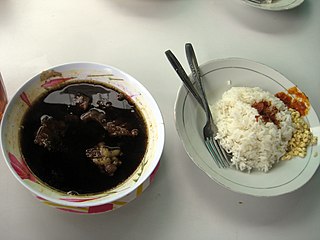
Rawon is an Indonesian beef soup. Originating from East Java, rawon utilizes the black keluak nut as the main seasoning, which gives a dark color and nutty flavor to the soup.

Peanut soup or groundnut soup is a soup made from peanuts, often with various other ingredients. It is a staple African cuisine but is also eaten in East Asia (Taiwan), the United States and other areas around the world. It is also common in some regions, such as Argentina northwest, Bolivia and Peru, where it can sometimes be served with bone meat and hollow short pasta or fries. In Ghana it is often eaten with fufu, omo tuo and banku often very spicy. Groundnut soup is also a native soup of the Benin (Edo) people in Nigeria and it is often eaten with pounded yam. Some of the essential ingredients used in making it are Piper guineense and Vernonia amygdalina.
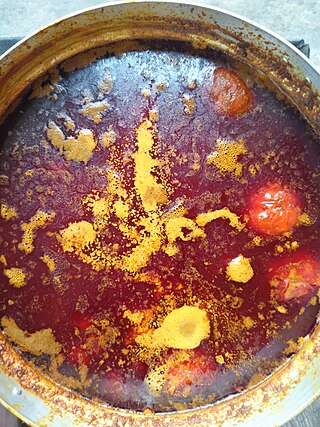
Palm nut soup or banga is a soup made from palm fruit common in the Cameroonian, Ghanaian, Nigerian, Democratic Republic of Congo and Ivorian communities. The soup is made from a palm cream or palm nut base with stewed marinated meats, smoked dried fish, and aromatics. It is often eaten with starch, fufu, omotuo, banku, fonio, or rice. The use of the palm fruit in cooking is significant in Ivorian, Cameronian, Nigerian, Ghanaian, Liberian and other West and Central African cuisine.
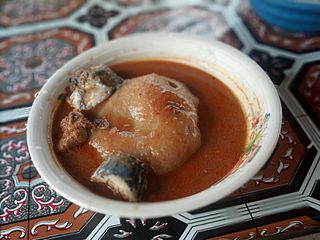
Kokonte, also known as abeti3, lapiiwa, lapelawa or “face the wall”, is a staple swallow food eaten in some parts of Africa including Togo, Ghana and others. In Ghana, kokonte is eaten by most of the ethnic groups like the Ga, Akan, Hausa, Kokonte usually is brown, grey and deep green depending on the type of ethnic group that prepares the dish. Kokonte is usually prepared out of dried cassava or yam.
Plakali is a staple food mainly prepared by the Ahanta and Nzema peoples of the Western region of Ghana and Côte d’Ivoire. It consists of cassava dough cooked in hot water, and it is similar to banku, another Ivorian and Ghanaian staple food, and fufu. Plakali is eaten with palm nut or groundnut soup.

Aprapransa, originally called 'Akplijii ' is a Ghanaian GaDangme dish prepared by heat mixing roasted corn flour with a sacred GaDangme soup called 'Palm Nut Soup'. As a point of emphasis, 'Palm Nut Soup', an important base ingredient in the preparation of 'Akplijii', is an ancient sacred soup of the GaDangme people, and is always prepared as a complement to another sacred corn flour meal called 'Kpokpoi(or Kpekpele)' during an 'Ancient Religious Hebraic Harvest Festival' called 'Homowo'. The GaDangme people brought these practices along with them to 'Ancient-Ghana' and taught all the tribes how to prepare this delicious 'Palm Nut Soup', just like the 'Akans' taught all the tribes how to prepare their delicious soup called 'Abunebunu(or Ebunuebunu)'. It is worth mentioning that outside Ghana, other tribes such as the Yorubas, Igbos, etc. in Nigeria process 'Palm Nut' in a similar yet different fashion into soup called 'Banga Soup'. Over the course of time, the knowledge of the preparation of 'Palm Nut Soup' in Ghana became common and it lost it sacred status. It may interest Ghanaians to know that the GaDangme people have from 'ancient time' to 'present day', used the palm tree in a number of sacred ways; namely, (1) To prepare a sacred soup called 'Palm Nut Soup',, (2) The burning of the dry figs as incense for spiritual cleansing and to ward-off evil spirits, (3) To build new houses every year made up of new palm tree branches which in our present day has been seriously reduced in practice because of embraced modernity in socio-cultural attitudes, (4) etc. The sacred uses of palm tree is not unique to the GaDangme(or Ga)-Tribe, for it is a common practice among several other tribes in the 'Congo-Niger Family'(or Bantu-Zone) of Africa. Akplijii(or Akplidzi) also known as Aprapransa is a food that is served on special occasions and it is feared to go extinct.
A cream soup is a soup prepared using cream, light cream, half and half, or milk as a key ingredient. Sometimes the dairy product is added at the end of the cooking process, such as after a cream soup has been puréed.

Ayam buah keluak is a traditional Peranakan dish consisting of chicken (ayam), tamarind gravy and buah keluak nuts. It is normally served with rice. It is also one of the favorite dishes of Singapore's founding Prime Minister, Lee Kuan Yew and his son, Lee Hsien Loong.
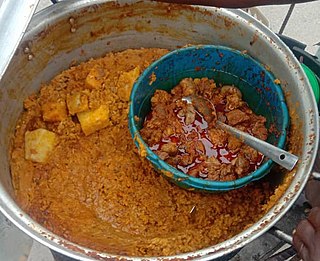
Banga Rice is a traditional Nigerian food prepared with palm fruit like in palm nut soup. The dish is common among the Urhobo people of southern Nigeria. Banga is the juice extracted from palm nut fruit. It is called Banga rice after the juice extracted from the palm nut is cooked with parboiled white rice.
Kanuchi is a hickory nut soup eaten originally by the Cherokee people and which consists primarily of ground hickory nuts boiled in water. Hickory was the nut of choice, since it is a nut tree endemic to North America, and is known to grow plentifully in those forested areas settled by the Cherokee.














